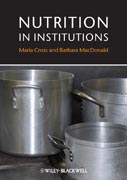
This insightful new book looks in detail at five institutions: schools, hospitals, care homes for the elderly, prisons and the armed forces. As well as providing a fascinating history of the provision of food in each institution, each section considers: current policy and standards and their implementation adequacy of food provided with regard to the health status and dietary requirements of the people in the care of each institution efficiency of catering organization and issues relating to contract tendering, expenditure and procurement.A broad spectrum of further relevant issues is also covered, including the meaning of food to those in institutions and determinants of choice. This book is an excellent reference for all dietitians, nutritionists and health professionals engaged with the care of others. Managers within these institutions, policy makers, food manufacturers and caterers will also find it a fascinating and useful tool. INDICE: Dedication. Acknowledgements. Introduction. Part 1 Schools (Maria Cross). 1.1 Introduction. 1.2 The health of UK schoolchildren. 1.3 A history of school meal provision to 2001. 1.4 Childrens diets prior to the introductionof nutritional standards in 2001. 1.5 The 2001 national nutritional standards. 1.6 Monitoring the 2001 standards. 1.7 Nutritional adequacy and meeting standards. 1.8 Childrens dietary choices post introduction of 2001 nutritional standards. 1.9 Nutritional standards in Scotland. 1.10 Nutritional standards in Wales. 1.11 Nutritional standards in Northern Ireland. 1.12 Government initiatives to improve the diets of children. 1.13 Non-government initiatives to improve food in schools. 1.14 The run up to the 2006 food-based standards and 2008/09 nutrient-based standards. 1.15 Interim food-based standards for school lunches. 1.16 Food-based standards for all other school food and drink. 1.17 Nutrient-based standards. 1.18 Final food-based standards. 1.19 Diverse diets and special dietary needs. 1.20 Target Nutrient Specifi cations. 1.21 Monitoring the new standards. 1.22 Current system of meals provision. 1.23 Catering contracts. 1.24 Catering staff. 1.25 Expenditure. 1.26 Procurement of school meals. 1.27 Free school meals. 1.28 The lunch box. 1.29 Food and cooking in the national curriculum. 1.30 School food post new standards. 1.31 Determinants of choice. 1.32 Diet and behaviour. 1.33 Good practice. 1.34 School meals in Europe and the US. 1.35 Discussion and conclusion. Part 2 Hospitals (Barbara MacDonald). 2.1 Introduction. 2.2 The development of workhouses. 2.3 Food provision. 2.4Current decade. 2.5 Other initiatives. 2.6 Alternative hospital catering facilities. 2.7 Events in 2007. 2.8 Hospital food Scotland. 2.9 Hospital food Wales. 2.10 Hospital food Northern Ireland. 2.11 Hospital food Europe. 2.12 Conclusion. Part 3 Care homes for the elderly (Barbara MacDonald). 3.1 Introduction.3.2 Workhouses. 3.3 Reform and the development of care homes. 3.4 Current decade. 3.5 Other initiatives. 3.6 Developments in 2007. 3.7 Scotland. 3.8 Wales.3.9 Northern Ireland. 3.10 Europe. 3.11 Useful resources. 3.12 Conclusion. Part 4 Prisons (Maria Cross). 4.1 Introduction. 4.2 The prison population. 4.3 History of prison food. 4.4 Food today. 4.5 Catering standards. 4.6 Expenditure, procurement and staffing. 4.7 Monitoring standards. 4.8 Nutritional adequacyand meeting standards. 4.9 Good practice. 4.10 What prisoners choose to eat, and what they know about healthy eating. 4.11 The prison shop. 4.12 The healthof people in prison. 4.13 Diet, nutrition and criminal behaviour. 4.14 Prisons worldwide. 4.15 Discussion and conclusion. Part 5 Armed forces (Maria Cross). 5.1 Introduction. 5.2 History of feeding the armed forces the Army. 5.3 History of feeding the armed forces the Navy. 5.4 Current provision. 5.5 Food and nutrient guidelines. 5.6 The provision of food during operations. 5.7 Monitoring of standards. 5.8 Catering costs. 5.9 Catering contracts and procurement. 5.10 Catering training. 5.11 Nutritional requirements of armed forces personnel. 5.12 Nutrition education. 5.13 Competitions. 5.14 Discussion and conclusion.Index.
- ISBN: 978-1-4051-2125-5
- Editorial: Wiley-Blackwell
- Encuadernacion: Rústica
- Páginas: 440
- Fecha Publicación: 09/01/2009
- Nº Volúmenes: 1
- Idioma: Inglés
